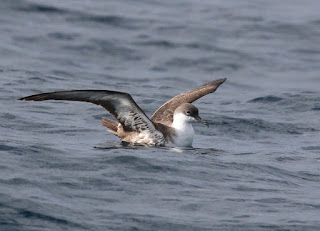We headed out to sea off Virginia Beach this Saturday on smooth seas under fair skies. (sunrise by Kate Sutherland)
It was a nice dry ride and a great morning to scan the horizon for birds. As we passed Cape Henry, we encountered a breaching Humpback Whale. There were good numbers of gulls, gannets, and loons on the move. Before 0800 we had seen seven flyby Razorbills, which was more than we saw all day a week ago.
As we continued offshore, the water warmed slightly from the mid to high 50s. We began to see several flocks of Bonaparte’s Gulls- mostly resting on the water. A couple of Manx Shearwaters passed by as we headed out. We did not see any Manx last week, so this was a nice change. A little after 0800, I headed a little off course to check out some flocks of Boneys, hoping to find some more shearwaters or auks among them. We did not find those, but we did get an adult Little Gull that stayed in view long enough for most people to see.
We had a lot of folks who were keen to see some of the pelagic birds that we had found a week ago, so we pressed onward and I set a course for the warmer water where we had some luck on that trip, which was about 50 miles off the Cape. A single Red Phalarope passed us as we moved along, but it generally got pretty quiet the farther we got offshore.
The slight seas were good for scanning the ocean, but instead of alcids or phalaropes, we were spotting Common Loons and Loggerhead Sea Turtles (photo below by Brian Patteson).
It was nice to get a good look at a Loggerhead this week. We seem them frequently on winter trips off Hatteras, where we have 50 to 70 degree water even in February, but if they stay too long off VA they risk getting stunned by the cold water.
50 miles out the water was even warmer. Like last week, it was in the low 60s, which is plenty for turtles but not good for alcids. Birds were sparse. There were a few gulls and gannets, but they seemed well fed and it was hard to coax them to the chum. We dispensed some menhaden oil as we cruised around, but there were no tubenoses to be found.
Knowing there was more life inshore, it was hard to stay out in the warm water desert. We did see an American Coot about 45 miles out, and this was probably a sign that the real pelagic birds would be much farther out to sea. A Great Black-backed Gull was sticking close by the coot.
Kate was eventually able to lure a few gulls and gannets to the stern with her tireless chumming, but no kittiwakes showed this time. As we got back inshore, we did find a few flocks of Bonaparte’s Gulls (photo by Kate Sutherland) working for bait over feeding schools of Little Tunny.
It seemed like most of the birds had moved even father inshore though and a single Manx Shearwater crossed the bow when we were less than 11 miles off the Cape. For the county listers, it was actually a little closer to Fisherman’s Island, so you know.
There was a good bit of activity at the mouth of the bay as we approached Cape Henry, and there was a nice movement of Red-throated Loons, and a few diving gannets. Laughing Gulls were still much in evidence, so it didn’t seem much like winter. We also had a few Lesser Black-backed Gulls, and a quick look at a Humpback Whale very close to Fort Story. We got back to the dock around 1730, just as it was getting dark.
I would like to thank everyone who came out on the trip. We had a full boat. I would also like to thank the leaders- Kate Sutherland, Ned Brinkley, and Ellison Orcutt. I wish there had been some more seabirds, but we had a remarkable period of fair weather preceding the trip, and abnormally warm temperatures. It looks like temps will be getting closer to normal in the days to come, and our next trip is not until January 2, so there is plenty of time for a change. We have three more trips in VA- all in January- and space is available.
Manx Shearwater- 4
Red Phalarope- 1
Little Gull - 1
Razorbill- 9
Also seen offshore- Common Loon, Northern Gannet, Great Blue Heron (1), American Coot (1), Great Black-backed Gull, Herring Gull, Bonaparte’s Gull
Marine Life
Humpback Whale- 1 or 2
Loggerhead Turtle- 7
One more sunrise picture! (Kate Sutherland)
Bonaparte's Gulls (Kate Sutherland)
young Bonaparte's Gull (Brian Patteson)
Great Black-backed Gull over the stern (Kate Sutherland)
Northern Gannet in the afternoon light (Kate Sutherland)
& a gorgeous sunset to end the day






















